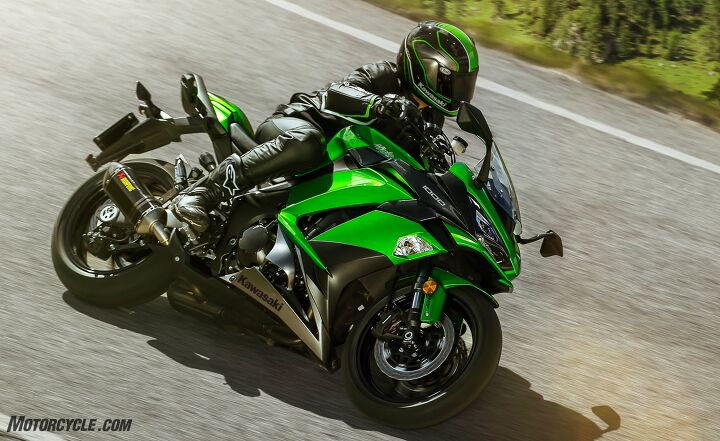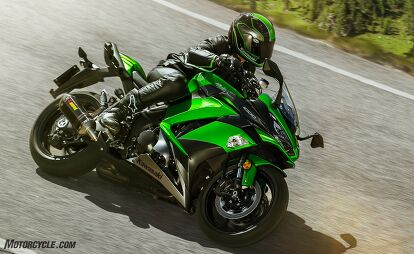Five Fast Facts About The 2017 Kawasaki Ninja 1000

Above-average owners and reduced insurance rates
Hopefully, you’ve had a chance to read MO’s first ride review of the 2017 Kawasaki Ninja 1000 ABS. If not, you should go take a look at our impression of Kawasaki’s gentleman’s sport-touring motorcycle. From its aggressive good looks to its romping engine, the Ninja 1000 has a lot to offer someone who likes their open-class performance wrapped in a highly streetable package.
2017 Kawasaki Ninja 1000 ABS Review – First Ride
Although we thought we were pretty familiar with the riders who favor the Ninja 1000, Kawasaki opened its private stock of information at the 1000’s press launch. Drawing from owner surveys, Big Green gave us a clear peek into who loves these bikes and how the company plans to better serve them.
1. Ninja 1000 owners make more than double the national average income
According to the Census Bureau, the median annual household income in the United States is $51,000, and the top 25% of the nation’s earners make more than $85,000 per year. The Motorcycle Industry Council places the median household income of motorcyclists at $64,000. (But we already knew that motorcyclists were richer than your average citizen!) Kawasaki’s owner surveys places the median household income for all Ninja buyers at $91,000. However, the Ninja 1000 owner tops them all with a median household income of $118,000!
2. Ninja 1000 owners are experienced riders
According to Kawasaki, Ninja 1000 owners are, on average, 47-year-old guys with 19.4 years of riding experience under their belts. Additionally, 70% have taken a formal rider training course, meaning they’re both experienced and educated. When it comes to riding, they spend 83% of their time solo, so the Ninja 1000’s passenger accommodations are largely untapped. Here are some other tidbits: Ninja 1000 owners spend 40% of their riding time on the twisty roads sport riders love. They’re lucky enough to only spend 20% of their time on surface streets and 18% on the highway. This tells us that the Ninja 1000 is a purely recreational purchase. Surprisingly, only 16% of their ride time is spent on long-distance touring.
3. 54% of buyers add bags at time of purchase
While we’ve noted on all of our road tests – and complained, loudly – about the fact that the Ninja 1000’s bags are an accessory purchase, only 54% of the buyers add bags at the time of purchase. That means that 46% of the buyers are content, at least initially, with the Ninja sans luggage. Kawasaki does not, however, have statistics on how many purchase the bags at a later date. The 2017 Ninja 1000 makes the addition much easier than the previous generation since the grab rails have the mounting points built-in.
4. The Ninja 1000 is Kawasaki’s most requested test bike for long-term loan
Before you accuse us of navel-gazing, consider this: Motojournalists have the pick of all of a manufacturer’s available models, meaning they could request the baddest, fastest, coolest, newest, most technologically packed bike Kawasaki offers. Instead, they choose to request the Ninja 1000, which says something about the bike’s versatility. The Ninja 1000 – with or without bags – is a great companion for backroad shenanigans or even the occasional track day (though that is a time that journos will go for sexy-fast machinery). However, hyper sportbikes don’t do so well in the daily commute or weekend touring. Yeah, they can do it, but they aren’t ideal. When you toss in the optional bags, you’ve got a tool that can take care of 90% of the things you might want to do on a street bike.
5. Kawasaki is addressing the high insurance rate issue
Kawasaki says that the number-one complaint about the Ninja 1000 from its owner’s survey is the cost of insurance. Since this complaint came from a whopping 48% of the Ninja 1000 owners surveyed, the company set out to try to rectify the issue. Case-in-point, Kawasaki contacted Nationwide Insurance about the Ninja 1000 and discovered that it was being lumped in with all 1000cc Ninjas. So, KMC set about educating Nationwide about how different the average Ninja 1000 buyer was when compared to the average ZX-10R buyer. After looking over the information Kawasaki provided, Nationwide has lowered its rates for the Ninja 1000 to more accurately reflect the owner’s demographic. Niinja 1000 owners should definitely check with Nationwide when it comes to insurance.

Like most of the best happenings in his life, Evans stumbled into his motojournalism career. While on his way to a planned life in academia, he applied for a job at a motorcycle magazine, thinking he’d get the opportunity to write some freelance articles. Instead, he was offered a full-time job in which he discovered he could actually get paid to ride other people’s motorcycles – and he’s never looked back. Over the 25 years he’s been in the motorcycle industry, Evans has written two books, 101 Sportbike Performance Projects and How to Modify Your Metric Cruiser, and has ridden just about every production motorcycle manufactured. Evans has a deep love of motorcycles and believes they are a force for good in the world.
More by Evans Brasfield







































Comments
Join the conversation
I'll be the first to call MO out if I deem it necessary, but I'll also back them up. This is a good site, with good personal. I check this site too much, and enjoy doing it. Don't know any of them, but I'd buy all of them a beer (at COTA in the KTM section next year, are we doing this?). Anyway...
The digital world, and publishing are constantly evolving. MO needs some leeway while they figure out how to stay ahead of the curve. If they stray from the base line we should call them out, but not crucify them.
Long live MO.
I find the statistic that Ninja 1K owners have an average annual income ~ $118,000 credible. A buyer will need that much to either buy the bike outright or finance one and be able to afford the insurance. It is encouraging that Kawi got through to Nationwide to provide a sensible rate for the bike. I hope they don't stop there.
This makes me wonder how significant a role the high cost of insurance has had on the decline of the sportbike market.